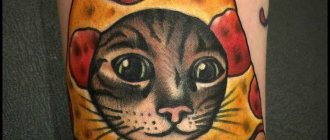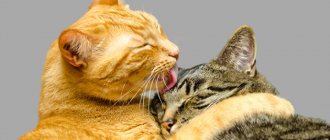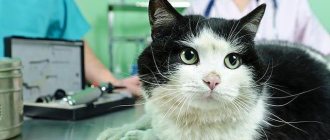Treating scratches at home
Most often, the owner decides to observe the development of events; in the end, the cat may itch due to nervousness.
If the cause is not determined correctly, the situation worsens and scratching becomes painful. The progression of the disease can be determined by the reaction of the animal, which does not allow the scratches to be examined or simply hides. There is another scenario for the development of events - the external scratching is delayed, and the infection that has “settled” on open wounds goes into the deeper layers of the skin. This happens for two reasons - complete ignorance of the problem or treatment of the animal’s skin at random.
Simply put, when you see a scratch or scratch, you should not smear it with all the ointments that can help; it is better to adhere to the standard treatment regimen or consult a doctor. If abscesses and boils form, you need to consult a doctor, since for recovery you need to remove the infection from the deep layers of the skin as quickly as possible. If the veterinarian doubts that the cat's immune system is functioning at full strength, non-steroidal anti-inflammatory drugs may be prescribed.
Note! Scratching is called a hot spot because the body temperature in the affected areas is usually higher than the base temperature.
If the inflammation does not seem extensive or painful, treatment at home comes down to preventive measures. If you do not allow infection to occur, and the cause of scratching does not lie in illness, the wounds will heal within a few days.
To disinfect and relieve discomfort, wounds are wiped with non-alcohol tincture of calendula. It is best to buy a collection of herbs and make a decoction yourself. If you need to act quickly, and only an alcohol solution is on hand, you need to fill it with hot water or boiling water so that the alcohol evaporates as quickly as possible.
Local discomfort is successfully relieved with cool lotions. For cooling, you can use herbal decoctions - oak bark, calendula, chamomile, etc. You need to be careful with lotions because wounds need to dry out to heal. By the same logic, scratches should not be bandaged or sealed. If the cat actively licks wounds, use an Elizabethan collar or follow the regimen prescribed by the veterinarian.
Note! If a cat has scratches on its head, the use of a collar is mandatory and the main danger is not infection of the wounds, but in causing a traumatic brain injury during scratching with its paws.
If you want to rid your cat of scratching, you need to heal not the wounds, but the reasons for their appearance. The word comb comes from “to itch”, which means that the cat is bothered by itching. You need to understand that when the skin just itches, the animal does not tear the skin to the point of wounds.
Diagnosis of scratching and itching
Itching is probably one of the most unpleasant sensations that can only be relieved by scratching. It has been proven that a person can become psychotic if they experience itching and cannot scratch themselves. Itching in an animal is a clear sign of skin damage, although it can occur before obvious symptoms appear. In veterinary medicine, as in human medicine, itching is distinguished depending on its nature:
- Localized – one or more specific places are itchy, for example, scratching appears only on the face or on the neck and cheeks.
- Generalized – when the cat’s entire body itches.
If you notice that your cat is scratching hard, you need to consult a doctor, because even in a veterinary clinic, it is very difficult to establish the correct diagnosis. Typically, the doctor suggests conducting an examination by scraping the skin, treating the cat’s scratching and observing the dynamics.
Laboratory analysis of scrapings should reveal the causative agent of the disease, but this does not always happen, since the causes of itching are not always “on the skin”. For example, stress can lead to a generalized type of itching, the cause of which cannot be detected by any analysis.
Note! When visiting a doctor, you should collect at least a minimal analysis, because if, in your opinion, the cat is itching a lot, the doctor must be sure that this behavior is not related to hygiene.
For example, during shedding, cats itch more and lick themselves more intensely in order to improve blood circulation in the skin and get themselves in order.
It’s a little strange, but in fact, many owners turn to the veterinarian because the animal has scratching, bald spots, wounds, but without itching. That is, the owner did not notice that the cat was scratching more than usual and believes that the scratching occurred on its own. Sometimes, the owner notes that the four-legged dog did not itch more than usual, but washed itself very intensively and had bald spots - this is the result of licking.
Hypothetically, this situation is possible, but in practice, it is most often associated with itching. An experienced veterinarian can easily distinguish between a scratch and a licked wound, that is, he will determine that the cause of the problem is itching. In the case of licked wounds, a completely different diagnosis is carried out, since the causes of their occurrence are not so varied and obvious.
Treatment: how to act correctly?
When a cat itches due to a food allergy, treatment depends solely on the cause of the disease - poor quality food. Other types of allergic reactions should also be treated by eliminating the allergens. If your cat is itching a lot, you can relieve the symptoms of itching with Stop-Itching. When infected with skin parasites, the cat is washed with antiparasitic shampoos - “Bars”, “Advantage”, “Pride”. Flea sprays “Frontline”, “Advocate”, “Bolfo”, and a collar “Foresto” help. For lichen and fungi, “Griseofulvin”, “Terbinafine”, “Itraconazole”, “Fungin”, “Zoomicol” are effective. Endocrine disorders can be treated with hormonal drugs, which the veterinarian prescribes individually.
Depending on the reasons that cause itching, medications are used, for example, Enwire will help against worms.
If a cat has an itchy back or other part of the body due to helminthiasis, the drugs Drontal, Enwire, Stronghold, and Profender are recommended. If your cat often itches near its ears, anti-mite drops “Barrier”, “Anandin”, and “Advocate” are suitable. When the causes of itching are eliminated, treatment of the cat includes the use of zinc ointment and Levomekol liniment, which promote the regeneration of sores. “Purified, mineralized sulfur” and vitamin A preparations are effective for restoring the skin and coat. You can also make lotions from decoctions of chamomile, string, and St. John's wort.
Causes of scratching
The first thing the doctor will do is examine the animal for the presence of parasites. Flea scratches appear all over the body, most often on the cheeks, neck, chin and at the base of the tail. In most cases, even if the animal has recently been treated, parasites are the cause of the itching.
The cat itches because the saliva of blood-sucking parasites always causes an allergic reaction. If you have ever been bitten by a flea or tick, you know that the bite itself is not felt, but afterwards it itches a lot. Flea saliva, injected under the skin, acts as a pain reliever, but since it has a protein base, after some time an allergic reaction occurs.
Note! The development of a flea allergy does not always imply the presence of a large number of parasites; for cats with sensitive skin, a few bites are enough for scratching to appear.
The next most popular reason is microscopic mites. Itching from mites is incomparably stronger than allergic; the area affected directly depends on the method of parasitism. For example, when infected with ear mites, a cat scratches the skin near the ear, forehead and back of the head within 24 hours. The subcutaneous mite can settle on the back, body, under the arms or even on the tail. To confirm or refute the diagnosis, a scraping is taken from the damaged skin for laboratory examination.
During laboratory analysis, scrapings are also checked for the presence of spores, which will indicate a fungal infection of the skin. Cats, dogs and people constantly have fungi and microorganisms living on their skin; not all of them are friendly, but the symbiosis is designed so that the bacteria do not attack the host. When the level of immune defense drops or an active, unfriendly culture is introduced, the cat may develop microsporia, which for many is more commonly called lichen.
Statistically, cats are more likely to get ringworm, but are practically not susceptible to other skin ailments. If the diagnosis is confirmed, the veterinarian will prescribe a course of treatment. Typically, treatment for ringworm involves injections or oral medications. Scratching should be smeared with antiseptic ointments with an antifungal effect.
Important! The symptoms of itching and allergic skin reactions are very similar (redness of the skin, itching, scratching), but are treated differently.
Causes
There are the following external and internal causes of acne.
External
Acne on the Sphynx's tail
Oily or sticky food remains on the chin and contaminates the pores of the sebaceous glands. The cat cannot clean the area that is inaccessible for licking. Plastic dishes absorb food debris on which microflora settles. It cannot be washed off and when the chin rubs against the wall of the bowl, bacteria penetrate through the pores into the sebaceous gland.
If you don't wash glass or ceramic dishes, the same thing happens. If you do not clean the tray or bedding in a timely manner, the dirt comes into contact with the skin not protected by fur and infects the sebaceous glands on the tail of a hairless cat.
Be sure to read:
A cat has a lump under the skin on its stomach: what is it, causes and treatment, what to do if it festers
Allergies as a cause of itching and scratching
If all of the above reasons are excluded, the doctor will assume an allergy.
Food allergies
If you're lucky, the allergy will be food, that is, caused by eating foods or feed that are not entirely suitable for the cat. Food allergies are identified by taking a detailed history. It is important to remember what you fed your ward for the last 10 days, did you change the food, did you treat it from the table, etc. To alleviate the condition, the animal is transferred to a neutral diet and supported with antihistamines. How to recognize allergies in the video below:
Gradually, the cat’s diet begins to expand by one product at a time and the reaction is monitored. Many purebred cats are allergic even to different types of meat. Recently, allergies to store-bought chicken meat have become very common, apparently due to the solutions used to treat carcasses. Eliminating food allergies will take time; the quickest option is to switch the animal to high-quality hypoallergenic food.
Non-food allergies
Non-food allergies are much more troublesome, since the pet’s reaction can be associated with any object in the home. First of all, bowls and bedding are changed. By the way, if you recently washed your cat’s bed, the cause of the allergy may be in the detergent. The cat is not bathed with shampoos and is kept in as neutral an environment as possible. During all preparations, the animal is prescribed antihistamines.
Important! Determining the type of allergy a cat has through testing is not entirely relevant. When an animal is already scratching, the immune system is very stressed, which can give false positive results.
Non-food allergies can be seasonal, for example, during the flowering of grass, a cat may develop a reaction to spores and pollen, in dry weather - to dust, etc. In this case, the animal’s condition will be alleviated only with antihistamines. Sometimes, the reaction is partially controlled by diet, since it relieves the general stress of the immune system.
Important! Atopic dermatitis is another type of allergy whose causes cannot be determined. It is believed that atopy occurs against the background of a combination of causes - dust, spores, pollen and other microparticles concentrated in the home.
If the veterinarian is unable to identify the cause of the allergy, the animal is given gentle therapy, which is carried out in courses and helps combat itching. Not the best, but sometimes the only option to improve the quality of life of the ward. The cat's condition must be constantly monitored, since atopy occurs for unknown reasons and can also disappear suddenly.
Advice: if a prompt appointment with a veterinarian is not possible, you need to treat the cat’s scratching with Levomikol, and you can use children’s Diazolin or Suprastin to relieve itching.
Why does a cat scratch its neck?
There are many reasons that cause itching other than flea infestation. The problem may lie either in the activity of other parasites or in individual intolerance to certain substances.
Parasites
When the most obvious cause of neck scratching, namely fleas, has been ruled out, you should not immediately stop looking in this direction, because other types of parasites may also bother the animal. So, itching can be provoked by:
- Subcutaneous mites that cause demodicosis - a disease that affects the skin and coat of a pet. In the localized form of the disease, the lesion occurs in a separate area of the body, for example, on the neck. In this case, the skin turns red, pustular rashes appear, the integument peels off, and the hair on the head, ears and neck falls out. The animal is primarily concerned about severe itching and the appearance of bleeding wounds, which are further scratched with claws. Cat subcutaneous mites of any kind are not infectious to humans. Two types of such parasites can live on a cat’s body: Demodex cati, which is conditionally pathogenic (it is part of the normal flora, but under favorable conditions it can multiply and cause disease),
- gatoi, a scabies mite that belongs to a pathogenic species and can be transmitted from one individual to another.
The gatoi scabies mite causes severe itching in cats and can be transmitted to other pets, but not to humans.
Dermatological diseases
Skin diseases can be caused by both changes within the body and pathogenic microorganisms:
- Fungal dermatological diseases (dermatomycoses) are a common cause of problems in cats, caused by mold and yeast infections. The most common disease in this group is lichen, the causative agent of which is the fungus microsporum, epidermophyton or trichophyton. The disease affects the hair follicles and skin. Ringworm is contagious and can be easily transmitted from cat to person, so owners should be vigilant, especially if there are small children in the house. The disease manifests itself in symptoms: round redness appears on the body, which itches and bothers the animal;
- peeling of the skin and hair loss are observed, which most often affects the area of the head, neck and limbs;
- When a secondary infection occurs, scratching can transform into festering wounds.
Ringworm most often affects the head, neck and extremities, causing itching, flaking skin and hair loss.
- traumatic - due to mechanical damage to the skin on the neck, burn or frostbite;
Allergic reaction
A nonspecific immune reaction to an irritant can occur in animals as often as in humans. Possible allergens that can cause itching in the neck area:
- feed;
- flea drops on the withers and an anti-flea collar;
- medications;
- shampoo and other hair care products.
An allergic reaction can be limited to local itching and redness, which causes the animal to itch a lot, or cause additional, more dangerous symptoms, including life-threatening swelling of the airways (Quincke's edema).
Video: a cat has an allergic reaction to a flea collar
Ringworm and other types of skin mycoses
Ringworm is a skin disease accompanied by:
- the formation of a small rash;
- damage to fur and claws.
This disease can occur due to a viral infection or reduced immunity of the animal.
There are the following factors that contribute to the development of lichen in pets living at home:
- walking outside without supervision;
- treatment with immunosuppressants;
- malnutrition;
- parasite infection;
- malignant formations.
The most common causes of ringworm in cats are those caused by fungal infections. There are several types of lichen:
- Ringworm , which is based on fungal diseases. This type is easily transmitted to humans, especially to young children. Fungal spores remain viable for 5-10 years because they are resistant to environmental influences.
- Versicolor or pityriasis versicolor , which is a dangerous disease. The cause of its occurrence is a yeast-like fungus, which under certain conditions transforms into a pathogenic form.
- Shingles or pink appearance , which appears when immunity decreases and is of an allergic nature.
- Eczema or tinea versicolor manifests itself in animals as an allergic reaction to a specific irritant and is not transmitted through contact with humans or other animals. Allergies can be caused by exposure to household chemicals, a malfunction within the body, or stress.
All types of lichen in cats have common symptoms.:
- hair loss;
- inflammation of the skin accompanied by peeling;
- change in pigmentation;
- severe scabies.
If you suspect lichen, the cat must be isolated immediately . A glazed balcony, loggia or separate room is suitable for this; you need to make sure that the room is warm. After this, you need to contact a veterinarian to establish through diagnostics the cause of the cat’s itching and methods of treating it.
To prevent such diseases from occurring in cats, it is recommended to periodically vaccinate them for preventive purposes.
How to look for the cause of itching
Having noticed that a cat scratches its neck until it hurts, the owner should pay attention to the characteristic manifestations of the problem. It is additional symptoms that may indicate the cause of discomfort:
- If, in addition to itching, your pet's hair falls out on the neck and ears, the skin flakes off and numerous crusts form, then most likely the reason lies in the activity of the subcutaneous mite. Demodicosis can be diagnosed at a veterinary clinic, where scrapings from the affected areas of the cat's skin will be taken for examination under a microscope. It is worth noting that if at least one gatoi mite is found in the samples, then the diagnosis is made immediately, but the conditionally pathogenic cati mite must be more than 2-3 pieces in one sample to make a diagnosis, because a small number of the representative lives on the skin of any cat and does not cause illness.
- Abnormal bowel movements, deterioration of appetite, decreased coat quality, “rolling” on the butt on carpets, combined with itching and scratching on the neck and body as a whole are signs of a cat being infected with helminths.
Infection with worms causes significant discomfort in a cat, causing it not only to itch, but also to roll on its butt and constantly lick itself
- A wound with signs of suppuration always indicates a bacterial infection, which can be either the sole cause of discomfort or secondary, occurring against the background of another disease.
- Redness of the skin area, the appearance of blisters filled with liquid, which gradually either dry out or open, forming ulcers, scabs and ulcers - these are symptoms of eczema.
With dry eczema, fluid-filled papules dry out, and with weeping eczema, they burst, forming ulcers.
- Hair loss, clearly defined red lesions on the skin, peeling are a typical picture for dermatomycosis. To make a clear diagnosis, a scraping will be required in the clinic - to prescribe treatment, the doctor needs to identify the specific causative agent of the disease.
If a cat has recently been put on a flea collar and it persistently itches around it, then most likely the animal is suffering from an allergic reaction - intolerance to some component in the preventive product has manifested itself. This is often observed after using flea drops - they are applied to the withers, and intolerance will cause a reaction in the neck area. Itching that appears after introducing something new into a cat's life, for example, another food, shampoo or medication, should also hint at an allergy.
An allergic reaction to a flea collar will be clearly localized on the animal’s neck
Description of possible causes
If your cat scratches its face a lot, but there are no other symptoms, then flea dermatitis should be ruled out. With allergies, fungal and bacterial infections, itching usually acts as a complication of the main symptoms (spots, redness, peeling, weeping, rashes and ulcers). In any case, it is necessary to keep in mind the following possible causes of this unpleasant symptom:
Stress. First, you need to exclude this option, since severe stress can trigger the appearance of psychogenic licking and itching. Therefore, if a cat scratches its face during a recent move, change of owners, childbirth or surgery, then there is a possibility that the reason lies in psychology. You can try to solve the problem by taking antihistamines for a short period of time. In most cases, improvement (if the cause is truly psychological) occurs within a few days.- Insect bites. Cats that have free access to the outdoors are most often affected. During the active season of insects, your pet may be subject to bites from mosquitoes, gadflies, flies, ants and wasps. And only the latter cause severe swelling and redness. In other cases, bites in the muzzle area are accompanied by severe itching, which causes the animal to scratch itself until it hurts. There is no such solution to the issue other than limiting access to the street during the insect active season. Itching and redness after bites almost always go away within a few hours.
Flea dermatitis. If a cat scratches its face until it bleeds, and there are black specks in its fur, then there is a high probability of fleas. You can pick them up even without going outside (anyone living in the house can bring insects on the sole of their shoes or clothes). In addition to itching, bald patches with redness of the skin inside will appear in different parts of the body. The main thing is to prevent the process from being complicated by a bacterial infection, since to add to all the troubles, purulent wounds will appear. You can get rid of fleas by treating the animal with Frontline Combo or Stronghold drops, which are evenly applied to the withers 2 times during the month. Subsequently, treatment is carried out monthly.- Acne. A real problem for hairless breeds. Most often, acne is localized on the chin, eyebrows, ears and forehead. Less common on the abdomen, base of the tail and limbs. Therefore, if a Sphynx scratches its face until it bleeds, then the possibility of acne is first ruled out. They can be superficial (the inflammatory process is mild) or deep (ulcers appear). A distinctive feature is itching, which causes the animal to scratch itself to the point of wounds. Therefore, acne is very often complicated by a bacterial infection. At the initial stage, in the presence of small lesions, antiseptic treatments with salicylic acid will be sufficient. In advanced cases, clindamycin and doxycycline may be added to treatments. Also, many veterinarians associate acne with hormones, so in difficult cases (constant relapses, large lesions) they recommend castration (sterilization).
Allergy. The most common reason that a cat scratches its face until it bleeds. It can be triggered by parasite bites (fleas, ticks), poor diet (most often), and contact with chemicals. Very often it occurs chronically throughout life with periodic exacerbations seasonally or after contact with a potential allergen. Treatment is individual, more symptomatic. But first, it is recommended to treat against fleas and ticks (since the bite of even one flea can provoke a severe allergic reaction to its saliva). Then they consider the option of changing food (in decorative breeds they may immediately suggest switching to hypoallergenic food). Everything else is very difficult to treat, since the allergen may be present in dust, mold, wool (carpets, clothes), which cannot be excluded. Such animals require maintenance therapy throughout their lives. Their main treatment is aimed at eliminating symptoms during an exacerbation.
Separately, I would like to say about demodicosis, which is rarely found in cats. And many do not know that it is not accompanied by itching. If, with demodicosis, your pet scratches its face until it hurts, then we can confidently say that it is complicated by a bacterial infection. To determine the pathogen, scrapings are taken from the lesions to the point of bleeding and sent for cytology. To solve the problem with demodicosis, you need to find and eliminate the cause that provokes it (severe stress, hormonal imbalance, postoperative period, allergies).
What to do if your cat scratches its neck until it hurts and bleeds
In any case, scratching the skin to the point of wounds should be a reason to take the cat to the veterinarian. Even if the cause is simple, the doctor will be better able to assess the animal’s condition and prescribe the most effective treatment. The range of therapeutic measures will depend entirely on the source of the itching.
Table: method of treatment depending on the type of disease
| Type of disease | Treatment |
| Demodicosis | Long-term (from 6 to 12 months), including a set of measures:
|
| Helminthiasis | Special anthelmintic drugs are used:
|
| Bacterial infection |
|
| Eczema |
|
| Allergy |
|
| Dermatomycoses | Treatment takes on average 1–2 months:
|
Photo gallery: drugs for the treatment of itchy wounds on the neck of cats
Imaverol for cats - emulsion for external use, a broad-spectrum medicine for various types of fungal infections
Stronghold has a complex antiparasitic effect
Miramistin - an antiseptic agent for treating wounds Triderm - a hormonal ointment that accelerates healing and stops the inflammatory process Vakderm - a vaccine against fungal infections used for cats for therapeutic and prophylactic purposes Cetirizine suppresses allergic reactions
It is worth understanding that itching and wounds due to scratching are only a manifestation and consequence of the disorder, so the problem will not disappear until its source is eliminated. Before going to the clinic, the owner should try to alleviate the animal’s condition. Bleeding wounds must be treated with an antiseptic (chlorhexidine, Miramistin, hydrogen peroxide), which will reduce the risk of secondary infection. You cannot carry out any activities with cosmetics - bathing with shampoo, applying creams, coat powders, etc.
If a cat develops lichen and the owner decides to give his pet a bath, this will only worsen the situation - the spots will “spread” all over the body very quickly.
It is also recommended to adjust the diet and exclude all those foods that are prohibited for animals (bread, bagels, sweets, sausages - products from the common table), since an unbalanced diet negatively affects the condition of the skin and can aggravate the course of diseases.
Video: sores on a cat’s neck - what to do
Treating cat itching at home
Treatment for itchy skin depends on the cause of its occurrence. As a rule, therapy includes a set of measures to eliminate the disease.
Complex treatment
Complex therapy involves eliminating the cause of itchy skin, as well as relieving the unpleasant symptom.
If there is inflammation on your pet's skin, you should use anti-inflammatory ointments that are applied to the damaged areas of the dermis. Ulcers should be treated with various antiseptic solutions - Chlorhexidine, Miramistin.
Depending on the pathogen, the doctor prescribes a remedy aimed at its destruction.
An allergic reaction is treated with antihistamines and anti-inflammatory drugs.
The cat underwent a very complex operation on his jaw. There were large seams on both sides. He combed them constantly. They applied everything that the doctor prescribed. They put a collar on him. In two months, he himself took it off twice and tore everything into blood. Now the wounds have healed, everything is overgrown with fur. Today we decided to try to remove the collar, because... and we are tired, and the cat. And he again aggressively scratched his cheek until it bled. A little bit true, but that's only because we realized it. What kind of scabies does he have? What to do? I can’t imagine how long I’ll walk with this collar. Tomorrow we'll take him to the veterinary clinic. Maybe you can give me an answer in the meantime. Thank you in advance!
it was similar with the cat. It turned out to be an allergy. Change the food to a medicinal one
Trim the claws or glue special pads on them. Or does he not have claws??
Anything can happen. Inflammation (the fact that it is overgrown with hair is not an indicator), eczema, allergies, habit... But in any case, the cat is worried about this place, most likely the wounds have not healed completely (heal - they itch), or there is some kind of inflammatory process. You need to take it to the vet. For now, put the collar back out of harm's way.
The claws were trimmed before removing the collar. Did not help. I was also already thinking about caps, or whatever they put on nails. We'll go to the vet tomorrow. thanks for answers
Looks like an allergy. Maybe give him 1/4 tavigil.
If you don’t know what’s wrong with the animal, go to the veterinary clinic. NEVER give your animal human medications without a veterinarian's prescription. Even the most harmless medicine might. lethal for kateya. In general, for any deviation in health, I go with my cats to the veterinary clinic, without delay or self-medication. Believe me, this practice has saved the lives of my cats more than once. And a consultation costs only 500 rubles.
Home zoo!
drums in the apartment
Do you wash the toilet after guests?
Do you allow yourself mayonnaise sometimes?
Furniture
Which accommodation would you choose?
Do you allow yourself mayonnaise sometimes?
Do you wash the toilet after guests?
Maasdam cheese, where to use it?
Prevention
It is impossible to completely eliminate the possibility of disease and infection, but thanks to competent prevention it is quite possible to minimize the risks for your pet. Be sure to follow these recommendations:
- regularly prevent infection with endo- and ectoparasites: drops on the withers protect the animal for 4 weeks;
- the collar is valid from 2 to 6 months;
- It is recommended to give an anthelmintic to a cat that walks on the street once every 3 months, and to a pet at home - once every six months;
Regular prevention of parasite infestation, including fleas and worms, is one of the most important elements in preventing itching and sores on the neck.
Itching in a cat can be caused not only by a flea attack. If a cat scratches its neck severely until wounds appear, you should pay attention to other symptoms; perhaps the animal is infected with helminths or is affected by a fungal disease. Treatment involves eliminating the root cause and depends on the specific ailment.
The cat itches, chews itself, constantly licks itself: is this normal?
If an animal itches due to severe itching, then with sharp claws it damages the skin, causing infection.
During severe itching, severe irritation of pain receptors occurs, because of this the animal begins to lick and chew itself. The skin on the affected area turns red and wounds appear. The reasons for this condition are different. To relieve the symptom and understand what to do, the pet must be shown to a doctor.
When it's ok
Cats are clean creatures. They wash themselves after sleep and after eating. If your pet eats natural food, then after licking the fur it will smell like the food it ate.
The smell of eaten herring is especially strong. If the animal licks itself too much, then it needs a medical examination.
Signs of a pathological condition of an animal
The painful condition can be determined by itching of the skin or ears. With skin itching, you can notice how the cat itches a lot and tries to bite the source of its anxiety from under the skin with its teeth.
When the itching is localized in the ear, the cat tries to stick its paw deep into it to scratch.
During this period you may notice:
- constant scratching of the body with a plaintive meow;
- pronounced biting of the skin;
- hair loss, deterioration of its appearance;
- the appearance of dandruff, oily scales;
- the skin is covered with ulcers or red rashes in the form of small spots;
- parasites or their excrement are visible on the skin.
It is easy to help an animal if you notice deviations in behavior in time and take him to the clinic. An advanced disease is more difficult to cure.
Causes of itching in cats
It is easy to help an animal if you notice deviations in behavior in time and take him to the clinic
A cat chews itself and scratches itself when its skin becomes itchy.
There are several reasons that cause this condition:
- lichen;
- helminthiases;
- endocrine system problems;
- failure in the hormonal system;
- influence of stressful situations;
- the occurrence of skin diseases (fungus);
- there are insects in the fur that feed on blood;
- allergic reaction.
Be sure to read:
Why does a cat shake its ears and head constantly, causes of itching, how to help and what to do
First, the animal is checked for fleas. This is the main reason why your pet starts to itch a lot. Flea bite marks persist for about 1.5 months, causing itching. If there are no insects in the animal's fur, it must be shown to a veterinarian.
Lice, lice, mites, flea dermatitis and other parasites that cause itching
Infection with ectoparasites occurs through outdoor shoes. The skin becomes inflamed if there are traces of scratches or small wounds on it.
If they are not treated in time, the animal will scratch them. Suppuration will appear, which will lead to baldness or sepsis. Sulfur ointment or powder is used to treat wounds. The drug in powder form called Yuglone is the most effective and is recommended for use by veterinarians.
Infection with helminths as a cause of itching
Itching due to worms
If the animal is infected with worms, then:
- the pet itches and licks the anus area because it feels severe discomfort in this place;
- appetite deteriorates, stool changes, changes occur in the digestive tract;
- there are noticeable changes in the cat’s behavior (he is too excited or in an apathetic state);
- the skin is dry and flaky, and the coat becomes dull.
Important! Kittens also suffer from worms, having contracted them from their mother. As a preventive measure, animals should be regularly given a drug against helminth infection.
Hormonal and endocrine disorders
Major disorders of the hormonal and endocrine system:
- Improper functioning of the thyroid gland. At the same time, the fur becomes tangled, itching and dandruff appear. In some cases, cats go bald.
- Cushing's syndrome. Due to a malfunction of the adrenal cortex, the skin loses its elasticity and becomes thinner. Comedones appear on the back and sides of the animal.
- Diabetes. The disease manifests itself in the form of local baldness, dry skin, seborrhea, and dull hair.
Ringworm, fungi and other types of skin mycoses
If an animal becomes ill with ringworm (trichophytosis), then treatment begins immediately.
Similar symptoms occur when an animal's skin and coat become infected with fungal and yeast diseases. Dermatomycosis does not pose a danger to people; it is treated with antifungal drugs.
If an animal becomes ill with ringworm (trichophytia), then treatment begins immediately, since this disease can also affect humans. In the affected areas, hair falls out and bald patches appear in the form of circles. Therefore, areas that the animal scratches heavily should be carefully inspected.
Infectious skin diseases
Often itching and irritation are caused by infectious diseases:
- Cheyletiellosis (pityriasis scabies) occurs due to infection by a separate group of mites of the genus Cheyletiella. Insects look like small white dots moving around. You can find them along the back.
- Pyodermatitis is caused by bacteria. They infect not only the surface of the skin, but also penetrate into the deep layers of the epidermis.
- Notoedrosis is a contagious infectious disease that occurs due to ticks. Itchy mange is transmitted through contact with a cat.
- Demodectic mange is a rare disease spread by ticks.
Be sure to read:
Bald patches in a cat near the ears and above the eyes: reasons, what to do, how to distinguish normality from pathology
Ear parasites
Due to improper care, parasites appear in the animal’s ears. Ear mites (otodectes) infect the ear canal and cause severe itching.
An unpleasant odor emanates from the ears, which is accompanied by dark-colored discharge. In the affected areas, the skin becomes red, the animal constantly scratches its ears and shakes its head. Huge wounds appear behind the ears due to constant scratching.
Body temperature rises. The progression of the disease can lead to severe inflammation of the outer ear and parotid space. In such a situation, the cat tilts its head to the side and constantly walks in this position.
Causes and symptoms of itching to sores
Allergic reaction
If a cat constantly scratches and licks itself, this indicates that an allergen has entered the body and the immune system is responding. This is due to histamine, which is released in large quantities and enters the bloodstream in response to a foreign agent. The cat scratches its neck, licks its belly, scratches its ears and muzzle. Often a runny nose appears, the eyes turn red, and the mucous membranes swell. In places where the cat has torn the skin, ulcers and bald spots form. Etiology:
- decorative cosmetics for animals and people;
- household chemicals;
- flowering plants;
- dust and mold in the room;
- host perfumes;
- food additives in low-quality feed;
- medicines;
- dandruff and hair of the owner.
Parasite infestation
Helminthiasis
If your pet scratches its skin and constantly licks its tail area, this indicates the presence of parasites.
When a cat constantly itches and licks, this indicates the presence of worms - roundworm, toxocara, hookworm, tapeworm. Helminths feed on beneficial substances that enter the cat’s body with food, injure the mucous membranes of the gastrointestinal tract, impairing the absorption process, and poison with toxins. Because of this, the animal does not receive vitamins and microelements, which negatively affects the skin. The cat scratches its skin until it bleeds and constantly licks itself in the tail area, becomes irritable, loses weight sharply, its appetite decreases, and blood may be present in the feces. Infection occurs by eating raw meat, drinking contaminated water, or by flea bites.
Skin parasites
When a cat scratches itself, experiencing severe itching, it means that subcutaneous mites have invaded. These are notoedrosis, otodectosis, demodex. Insects parasitize in the upper layers of the epidermis and infect the area around the eyes, behind the ears and inside the auricle, muzzle, eyebrows, head, and inner thighs. The cat scratches its neck until it bleeds, becomes aggressive, sleeps and eats poorly. Her fur falls out in clumps, and a red spot forms in place of the bald spot, which the pet combs out with her paw. If the cat is itching, but there are no fleas, this indicates a parasite bite and the body's reaction to substances contained in the saliva. One bite from a random flea is enough to cause flea dermatitis.
Ringworm (fungal infections)
Itchy sensations in a cat are caused by infection with fungal infections, which manifest themselves in the form of bald spots.
If a cat itches all the time and constantly licks itself, and bald spots and spots, small abscesses appear on the head and body, this indicates infection with fungi, including trichophyton and microsporum. A cat can become infected through contact with a sick animal and even at home, when fungal spores are brought in by the owner on street clothes. Candidiasis often occurs in cats, which affects the mucous membranes. Then the nose and eyebrow peel off, and the mucous membranes of the mouth and tongue are affected. If the rash occurs under the eyes, fungal conjunctivitis develops. Fungi can spread to internal organs, which leads to deterioration of all systems and severe itching. If a kitten itches, advanced mycosis can be fatal.
Pyoderma
If a domestic cat itches until it bleeds, pathogenic microflora - staphylococci or streptococci - enter the wounds. A purulent-inflammatory process begins, which covers individual areas or the entire body. Most often it occurs against the background of existing skin ailments - flea dermatitis, allergies, hormonal imbalance. It manifests itself as an unpleasant odor, the formation of purulent crusts and scabs, hair loss, and severe itching.
Endocrine diseases
According to veterinarian statistics, 8% of cases of impaired production of thyroid hormones are diagnosed in animals over 8 years of age.
A hormonal imbalance in an animal’s body causes aggression in it and awakens anxiety, against the background of which it constantly licks itself.
Disruption of the thyroid gland or adrenal glands leads to the fact that the cat’s back, limbs, and stomach itch. Provoking diseases are Cushing's syndrome, hyperthyroidism. Hormonal imbalance provokes a change in behavior, due to which the pet becomes aggressive, anxious, and begins to lick itself vigorously until bald spots form.
Treatment at home
Treatment at home includes taking medications and following a special diet.
Medicines for helminths
The drug is selected depending on the type of disease:
- Scabies from flea bites is treated with special drops and sprays. Anti-flea shampoos are used during bathing. Then a flea collar is put on the animal.
- Itching caused by fungal infections is eliminated with drugs from the griseofulvin group. The antifungal agent is applied externally. You can also get vaccinated.
- To get rid of ticks, acaricidal substances are used in the form of drops, sprays and shampoos. Drops against ear mites are instilled into the ears.
- To eliminate allergic reactions, it is necessary to remove the allergen from the diet and care products. For further treatment, antihistamines are used.
- Deworming medications help get rid of worms. During the examination, the doctor identifies what type of worms have affected the intestines and prescribes appropriate treatment.
- Dermatosis, otitis media and other infectious diseases are treated with antibiotics and anti-inflammatory drugs. To strengthen the immune system, the animal is prescribed vitamins A and B and immunostimulating drugs.
- Allergic dermatitis and ear scabies are treated with Stronghold. This drug is released in the form of drops that are applied to the animal’s neck. It also helps with flea bites.
Treatment of acne in cats
It seems that curing acne is easy, but if done inappropriately, serious complications can occur. To accurately determine the nature of the rash, you must consult a veterinarian. The diagnosis is made based on the clinical condition of the pet and laboratory tests to exclude other skin pathologies. The study will require a cytological analysis of the skin for microflora.
Comprehensive treatment of acne in cats is prescribed after confirmation of the main diagnosis, depending on the frequency of occurrence and degree of neglect of the disease. In some cases, the pet will be shown a special therapeutic diet with a minimal composition of fats. If a bacterial infection is present or the acne is enlarged and painful, your veterinarian may prescribe a course of antibiotics and supplemental vitamin A.
If blackheads are observed without inflammation, they should be treated with drying agents, having previously cleaned the area with a solution of chlorhexidine or hydrogen peroxide. Therefore, if your cat has acne on his chin, before consulting a veterinarian, you can start by carefully cleansing the affected area with disinfectants. Antiseborrheic shampoos are widely used to cleanse affected skin. When treating at home, it is recommended to follow a diet, follow the doctor's instructions and carefully monitor the hygiene and living conditions of the cat.
Some consider the use of folk recipes for treating acne in cats to be a more effective remedy. Indeed, there is advice from veterinarians on preparing solutions based on medicinal herbs for acne. But before you treat your pet yourself, you need to consult a veterinarian about the advisability of using folk remedies.
Veterinarian advice
Despite the risks of being outside, the cat needs fresh air, so you should not limit its freedom. Since infections and parasites are transmitted through hands or from other animals, preventative treatment against parasites should be carried out regularly.
Veterinarian advice:
- The animal must be kept clean.
- A good immune system will protect your cat from any infection. The key to health is proper and balanced nutrition.
- To prevent allergies, you should not include smoked and salty foods in your diet. Sweets are also prohibited.
- A change of owner or a sharp change in attitude towards a pet leads to stress and illness. A pet needs to be loved, cared for, and given enough attention.
Be sure to read:
The cat scratched its neck until it bled: what to do, what to apply, how to treat it
The cat licks and itches, but there are no fleas
A signal about the development of the disease can be constant licking of fur, scratching and excessive attentiveness to one’s appearance. Often the cat owner thinks that the pet has fleas, but when examining the fur, it is clear that this is not the reason.
Possible causes of itching:
- allergy;
- fungal diseases;
- hormonal diseases;
- hypo- and vitamin deficiencies;
- change of diet.
The cat licks itself vigorously and goes bald
Sometimes itching occurs for psychogenic reasons. Increased licking and scratching occurs when the animal is stressed. This is often observed when an individual requires mating. Taking sedatives will help calm your pet.
Cat licks after sterilization
Cats always try to lick wounds, sores and other skin lesions. After sterilization, a seam remains, which itches and itch, so the animal scratches and licks it. To prevent bleeding or other serious complications, a surgical collar is placed on the cat.
What to do if your cat is constantly licking
It can be difficult to diagnose why an animal constantly licks itself. First, the cat is checked for fleas, then it is analyzed whether the diet or care products have changed.
With a skin disease, the animal often shakes its head and licks itself until it bleeds. Only a doctor can diagnose the disease, so the pet must be taken to the clinic immediately. Based on the scrapings taken, they will be able to identify mites or fungal spores.
Diagnosis and treatment
Medicinal food for skin diseases and allergies
The cause of the disease is determined during a clinical examination. Collect anamnesis. Scrapings are made to exclude demodicosis and notoedrosis. They try to comb out black spots that resemble flea excrement. Allergies to food components, atopic and contact dermatitis, lichen, flea infestation, and eosinophilic granuloma are excluded.
The treatment strategy is developed by a veterinarian. Abscesses are not opened, and they are not treated with brilliant green and iodine tincture, so as not to completely clog the pores and provoke infection to penetrate deep into the tissues. The lesions are shaved to provide access to external remedies prescribed by the veterinarian.
Be sure to read:
The cat scratched its neck until it bled: what to do, what to apply, how to treat it
The treatment strategy is developing in the following directions:
- Ensuring compliance with sanitary and hygienic requirements for utensils for food and drink. Use ceramic or glass bowls. Keep the feeders clean and change the water regularly. If the cat has not eaten wet food within 15-20 minutes, it is thrown away and the dishes are washed.
- The use of external preparations with antiseptic, anti-inflammatory and wound healing effects. The course of treatment takes from two to three weeks.
- Diet therapy: the best option is to use therapeutic nutrition for cats with skin diseases. Adherents of natural feeding should create a diet that is approved by the veterinarian. Treats with human food are prohibited.
- Depending on the severity of the disease and at the discretion of the veterinarian, antibiotics, immunomodulators, and restorative drugs are prescribed orally or parenterally.
If rashes on the chin are symptoms of underlying diseases, the cause is eliminated.
Prevention of itching: does it exist at all, and what can be done?
Itching is caused by various factors, so following a number of prevention rules will help protect your cat from scratching:
- Poison worms in a timely manner. This will also help protect children who constantly play with animals. You should not give your cat raw foods: fish, meat.
- After each walk, inspect the animal for abrasions. Treat detected wounds with iodine or other disinfectants.
- To avoid infection with parasites, the cat should not be allowed to come into contact with other animals.
- Disinfect the cat litter box regularly.
- The transition to a new food should be carried out gradually.
- Do not punish your cat for minor offenses: this will prevent stress.
At the first manifestations of inappropriate behavior, the animal must be immediately shown to a specialist. You should not self-medicate, as there are many reasons why a cat may itch.
The doctor will help not only eliminate itching and painful scratching, but also the very reason for their occurrence. It is important to pay close attention to your pet in order to recognize a possible disease in the early stages.
Cat scratching its chin











